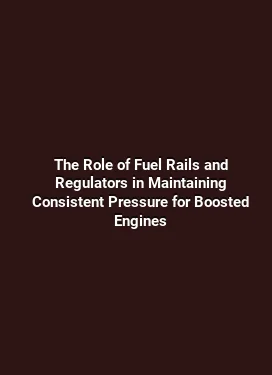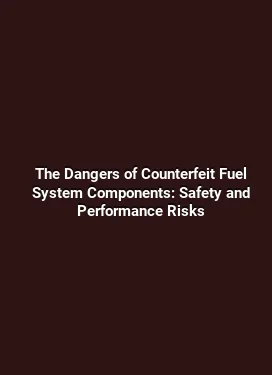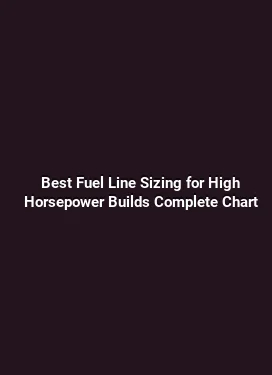How to Install Nitrous Oxide Wet Kit on Naturally Aspirated Engine
Introducing nitrous oxide to a naturally aspirated engine is a transformative modification that can deliver a measurable increase in horsepower when paired with proper fuel management and safe operating practices. A wet nitrous kit, which injects both nitrous oxide and additional fuel, provides a balanced approach to airflow, combustion, and reliability. This comprehensive guide dives into the practical aspects of selecting, installing, and tuning a wet kit, with a focus on intake and fuel system considerations, performance characteristics, and safe operation. The goal is to equip enthusiasts with the knowledge needed to execute a thoughtful upgrade that respects engine longevity and drivability while delivering meaningful gains.
Fundamental Concepts of Wet Nitrous Systems

Wet nitrous systems operate by delivering a precise mixture of nitrous oxide and additional fuel into the intake tract or intake port. The oxygen provided by the nitrous allows a greater amount of fuel to burn efficiently, resulting in a substantial horsepower increase. Key components typically include a Nitrous Bottle, a Solenoid Valve, a Fluid Line, an Injection Jet or Nozzle, a Controller or Activation Switch, and a Fuel Enrichment and Return system. Understanding how these parts work together helps in planning a reliable upgrade and anticipating maintenance needs.
From an intake perspective, the kit must integrate with the engine’s air path to ensure consistent air distribution, avoid hot spots, and maintain air-fuel ratios within safe limits. On the fuel side, the goal is to provide enough additional fuel to match the nitrous flow without causing overly rich conditions that could degrade performance or timing. The interplay of air, fuel, and timing defines the overall effectiveness and safety of the installation.
Choosing the Right Wet Kit for a Naturally Aspirated Engine
Selection begins with an honest assessment of the engine’s current state and the desired level of power enhancement. The kit should be compatible with the intake manifold, throttle body, and fuel system, and it should offer predictable performance across the RPM range that you plan to operate. A well-matched wet kit minimizes throttle response lag and ensures a smooth, linear power delivery rather than abrupt, unpredictable surges.
Consider the following when selecting a kit: the maximum horsepower gain, the quality and compatibility of the nozzle design, the reliability of the nitrous and fuel solenoids, the fuel delivery method (whether the kit includes a dedicated fuel pressure regulator and return line), and the ability to fine-tune the enrichment at different nitrous levels. It is also important to verify compatibility with any existing engine management system and to plan a safe tuning strategy that preserves engine integrity under load.
Key Components and Their Roles

The Nitrous Bottle stores compressed nitrous oxide and requires proper mounting, insulation, and safe handling practices. The Solenoid Valve controls the flow of nitrous and is typically actuated by a switch or a controller. The Injection Nozzle or Plate introduces the nitrous/fuel mixture into the intake tract, with placement and sizing influencing spray pattern and distribution. A dedicated Fuel Controller or piggyback system adds the necessary fuel, while a Bottle Warmer helps maintain consistent nitrous pressure for stable performance. Clean fuel supply, filtered air, and properly sized injectors are essential to prevent lean conditions and detonation risk.
Effective tuning relies on monitoring wideband air-fuel ratio (AFR), fuel pressure stability, and intake air temperature. While the practical details of EFI mapping vary by platform, a disciplined approach to logging data and making measured tweaks yields the most reliable outcomes.
Safety, Legality, and Practical Considerations
Safety remains a central pillar of any nitrous installation. Nitrous systems introduce higher cylinder pressures and accelerated combustion events, which can magnify weaknesses in the intake and fuel systems. Always verify component ratings, ensure secure mounting, and follow manufacturer guidelines for bottle pressure, nozzle sizing, and wiring. Protective measures such as proper heat shielding, fire suppression readiness, and clear vehicle labeling help mitigate risk in both street and track environments.
Legality and compliance vary by jurisdiction and usage context. In many places, nitrous systems require specific certifications, street-legal components, and adherence to noise and emissions standards. Before installing a kit, check local regulations and any track or event rules to avoid noncompliance that could lead to penalties or disqualification from participation.
Installation Planning and Workspace Preparation
Successful installation begins with a detailed plan that maps the entire modification, from mounting and routing to wiring and tuning. Prepare a clean workspace with adequate lighting, organized fasteners, and labeled lines. A service manual for the vehicle, a reliable torque wrench, and quality seals are essential tools for maintaining integrity at connections and fittings. Scheduling a test session on a dyno or controlled environment helps confirm that the changes behave as intended under real-world load and rpm conditions.
Plan for staggered testing: start with a conservative nitrous dose, monitor AFR and IAT behavior, and gradually progress while watching for abnormal knock or detonation. Document all parameters and ensure you can revert to a safe baseline if any issues arise during testing.
Detailed Installation Steps: Intake and Fuel System Focus
Approaching the installation with an eye toward intake and fuel system upgrades yields the most reliable and predictable results. The following steps emphasize practical, repeatable actions that professionals and enthusiasts can perform with proper care and supervision where needed.
Step 1: Verify Baseline Engine Health and Readiness
Before making any changes, perform a thorough check of compression, drivetrain integrity, and current ignition advance. A well-maintained block, piston rings, and valve train reduce the risk of detonation when nitrous is introduced. Baseline AFR in normal operating conditions provides a reference for future tuning. If the engine shows weakness, address it first to avoid compounding issues with nitrous use.
Step 2: Prepare the Intake Pathway
Ensure the intake system delivers clean, stable air without excessive restriction. If the engine already benefits from high-flow air filters, cold-air intake boxes, or upgraded intake manifolds, document these configurations to guide the nitrous spray placement and fuel enrichment strategy. The injection point should minimize interference with existing intake runners and avoid spray interference with throttle plates or MAF sensors. A correctly placed nozzle ensures even distribution and reduces the risk of backflow or puddling of the nitrous/fuel mixture.
Step 3: Fuel System Upgrades and Calibration
Fuel delivery must keep pace with nitrous flow to preserve the desired air-fuel ratio. Install a dedicated fuel solenoid linked to the nitrous activation and size the fuel rails, injectors, and pressure regulator to support the target nitrous dose. A return-line setup can help stabilize fuel pressure under load, while a dedicated fuel pump or upgraded high-flow pump ensures adequate supply. Fine-tuning AFR at multiple load points and RPM bands is crucial for stable operation throughout the nitrous activation window.
Step 4: Nitrous Delivery System and Bottle Management
Mount the bottle in a secure, vibration-resistant location away from heat sources. Attach proper shielding and a bottle warmer if required. Routing lines should keep the nitrous and fuel paths short and free from sharp bends that could restrict flow. The nozzle or plate should be installed with attention to spray pattern and spray angle, ensuring that the mixture reaches the combustion chamber efficiently. Always verify leak-free fittings and test the system with inert gas or a safe, controlled method before enabling nitrous flow.
Step 5: Electrical Wiring and Controller Configuration
Wire the activation switch, purge line (if included), and any controller hardware according to the manufacturer’s instructions. A reliable trigger method that integrates with the vehicle’s electrical system avoids misfires and unintended deployment. Grounding points should be solid and free of corrosion. The tuning logic may require timing retard to compensate for the additional energy release, alongside species-specific adjustments to ignition maps. Document all settings for future reference and safety checks.
Step 6: Safety Checks and Initial Testing
Perform a cautious initial test at low nitrous flow and verify that fuel pressure, AFR, and ignition timing respond as expected. Listen for abnormal engine noises and monitor exhaust emissions for signs of detonation or misfire. A controlled dyno session or a closed-track environment is ideal for assessing power gains in a safe context while collecting valuable data on fuel behavior, boost-like effects from increased cylinder pressure, and throttle response characteristics.
Practical Tuning Tips and Performance Optimization
Maximizing the benefits of a wet kit without compromising reliability involves careful tuning and ongoing monitoring. Concentrate on maintaining a stable air-fuel ratio, predictable spark timing, and consistent fuel delivery across the nitrous activation window. Real-world tips include starting with a conservative spray setup, incrementally increasing nitrous flow, and validating the results at multiple RPM bands to understand how the system behaves from off-boost to peak power range.
Incorporate trend-friendly variables such as throttle response, response latency, cylinder head flow, and injector duty cycle into your evaluation. Tracking these elements helps distinguish genuine power gains from short-lived spikes. Regular maintenance of the nitrous bottle, lines, and valves, along with periodic re-tuning after engine work, preserves peak performance and safe operation over time.
Operational Considerations for Street and Track Use
On the street, predictable power delivery matters as much as peak horsepower. For track use, repeatability and reliability are paramount. Ensure that the installation accommodates a clear deactivation path, so the system can be disabled smoothly during normal driving conditions. Document procedures for safe disengagement and re-engagement under varying loads. Engine protection features, such as detonation sensors or engine load monitoring, can provide additional layers of security during high-demand sessions.
By understanding the relationship between intake flow, fuel delivery, and combustion efficiency, drivers can make informed decisions about when and how to deploy nitrous under legal and safe circumstances. The right balance of hardware and tuning yields a practical, repeatable upgrade that complements the natural breath of the engine rather than forcing it into an aggressive operating envelope.
Long-Term Maintenance and Reliability Considerations
Keeping a nitrous-equipped engine reliable involves routine inspection of hoses, fittings, and seals for signs of wear or leakage. Regularly test the bottle pressure and inspect the nozzle area for any signs of corrosion or buildup. Schedule periodic checks of the fuel system’s pressure regulator and pump performance, especially after any changes to spray size or nitrous timing. A disciplined maintenance plan reduces unexpected downtime and extends the life of the installation while maintaining safe operation keys.
In addition, maintain a well-documented service history for the vehicle. This history supports future upgrades, helps diagnose issues quickly, and informs decisions about further enhancements to the intake and fuel systems as the vehicle evolves. By combining robust hardware with thoughtful tuning and proactive maintenance, the wet kit can deliver consistent gains while preserving overall drivetrain integrity.
Case Studies and Real-World Scenarios
Engine configurations vary widely, and the most successful setups illustrate the value of a cohesive strategy that aligns intake flow, fuel management, and controlled nitrous delivery. Case studies often highlight incremental gains achieved through careful nozzle sizing, refined AFR targets, and conservative timing adjustments. Real-world results emphasize the importance of data logging, repeatable testing, and a measured approach to increasing nitrous levels as the engine permits.
For enthusiasts seeking to explore further, the practical takeaway centers on building a strong foundation: verify engine health, upgrade the intake and fuel pathways in a balanced way, and approach tuning with a methodical plan that prioritizes safety and durability. This approach yields not only performance improvements but a more confident, enjoyable driving experience across different road and track conditions.






